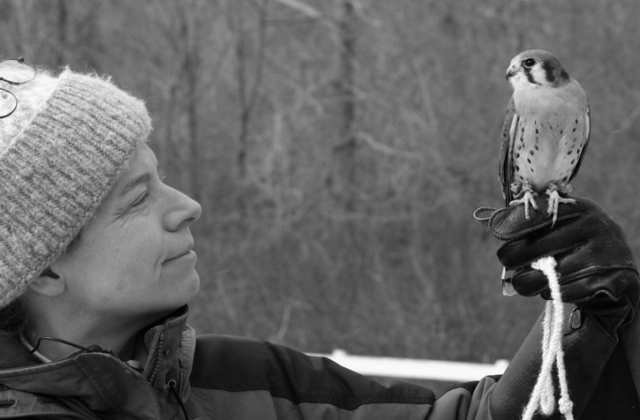Eileen Fielding of the Sharon Audubon Society: A Lifetime of Watching Birds
It’s Only Natural
Text By Jude Mead
Photo by Michael Moschen
If anyone knows about birds, it is Eileen Fielding. She started volunteering at an Audubon sanctuary in Massachusetts when she was 13. Today, with a Ph.D. in ecology and evolutionary biology from the University of Connecticut, she’s the center director for the Sharon Audubon Center.
Fielding is a longtime resident of New England and is involved in wildlife, landscape and conservation for this region. Birds, however, have remained her passion since childhood. In a recent interview, Fielding talked about her interest in and knowledge of birds.
What is the rarest bird you’ve spotted?
In 1980 I was offshore in the Gulf of St. Lawrence doing a bird survey and I spotted a gull I’d never seen before. It turned out to be a Little Gull—not technically rare but certainly very unusual in that area, as they don’t show up much in North America. It was fun to be the sole discoverer of that individual.
Are some birds disappearing?
Many of our forest birds, especially the ones that migrate here from the neotropics to breed and raise young, have been in steady decline for the past 50 years.
How is climate change affecting birds?
Climate change can affect birds in many ways. For example, changes in the timing of seasons can throw off the timing of food availability, whether the food is flowers, fruit, seeds or insects, so that a food supply the birds usually depend on is not there when the birds need it for migration or raising young. Extreme weather events can make migration more hazardous or cause nesting failures. Increased risk of drought or fire can also make habitats less supportive of birds. In the coming decades, dozens of species will very likely lose large parts of their current ranges to habitat alterations caused by climate change.
What is required for bird watching?
Eyes or ears and a little curiosity. I hope that people aren’t held back by the thought that you have to have special equipment. You can start with sparrows on a sidewalk or whatever comes to a backyard feeder. But once you’re hooked, you might want to start with a basic pair of binoculars and either a bird guide or access to a free downloadable birding app.
Can you give tips on the best bird guidebook? Apps?
There are plenty of good bird guides. Try Googling “birding guidebooks” or “What bird guide is best for you?” You might want a small portable one for the field that just helps you figure out what you’ve seen, and a more comprehensive one to keep at home that tells you more about the bird’s life history. Or get the best of both worlds with a birding app such as Merlin from the Cornell Lab of Ornithology or the Audubon Bird Guide App. The apps have the wonderful advantage of letting you hear bird calls and songs. Once you are identifying birds by ear as well as eye, you’ll detect many more species on your bird outings, especially in spring and early summer when everyone is singing.
When is best time to go birding?
My answer is that all times are good, but if you’re just getting started locally, any time from mid-April to late June will be the most rewarding. But there are special times and places to catch spectacular migration movements too, like catching shorebirds or waterfowl migrating along the coast in spring and fall, or watching hawks migrate down ridgelines in the fall.
Is there a difference between birding and bird watching?
People get different kinds of rewards from being out spotting birds. Some people have fun compiling the longest lists or bagging the rarest finds. Others like to sit still in one place or move slowly and take time to understand and observe what the birds are doing. That might be where you make the distinction between birding and bird watching.
Why do you think people enjoy bird watching?
I don’t know all the reasons. But it seems to me that birds are good at taking us out of our own heads and focusing on the world of nature instead of on the human world. It’s fascinating and refreshing and helps adjust our perspective, in my opinion.
What roles do habitat places and seasons play in bird watching?
Once you start birding, you might get a new eye for the significance of the seasons for birds, and the importance of certain features in the habitat for certain species of birds. For example, a weather system might be a great boost or hindrance to migrants. A dead tree looks like a woodpecker resource and a weedy field looks like a great hiding and foraging spot.
Where should one go to bird watch around here?
Practically anywhere! But the state forests, the land trust preserves and Audubon sanctuaries are a great place to start. Once you’re in the groove, you can find social media pages and rare bird alerts, or may plug into eBird, an online birding resource, that can give you more specific information about the best birding spots in general. And of course, you can link up with a local Audubon chapter like the Litchfield Hills Audubon Society to find folks who not only know the best spots but organize trips to visit them.
Once you have all things in place, how does one bird watch?
Just keep your binoculars handy and your eyes open and, especially, take a little time. As soon as you arrive somewhere, even your own yard, you need to give the birds time to stop reacting to your presence and start going about their regular behavior. Relax, be patient and enjoy whatever comes along, even if it’s one chickadee.
What is your favorite bird?
My favorite bird is the red-breasted nuthatch. It’s tiny, tough, beautiful, and comical. Seeing or hearing one always cheers me up.

